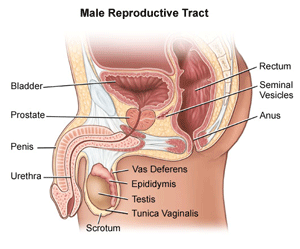The following is a list of the parts and definitions of the male reproductive anatomy:
Anus
End of the digestive tract; opening where solid waste leaves the body
Bladder
Located in the lower abdomen; muscular organ which collects urine to be excreted from the body through the urethra
Corpus Cavernosum
Pair of cylindrical tubes of porous soft tissue, located within the shaft of the penis. When the male is sexually aroused, the corpus Cavernosum becomes engorged with blood, making the penis stiff and hard. This is called an erection.
Epididymis
Organ that is a coiled tube, found at the back of each testicle; tubing functions to store sperm while they mature and then route them out throughout the vas deferens.
Penis
Male sex organ. The two main parts are the shaft and the glans (head or tip of the penis). The shaft is comprised of the urethra and two cylindrical tubes of porous soft tissue, called the corpus Cavernosum. The purpose of the penis is for inseminating during sexual intercourse and draining of urine from the bladder.
Gland
Slightly larger than a walnut, this gland surrounds the urethra. It is located directly beneath the bladder and in front of the rectum. The prostate produces a milky-type fluid, called prostatic fluid. Prostatic fluid helps protect the sperm from the acidity of the vagina. The prostate also has smooth muscles that assist in expelling of semen during ejaculation.
Rectum
The final section of the large intestine before solid waste reaches the anus to be excreted
Scrotum
Skin and smooth muscle that forms a sack to house the testicles; protects and regulates temperature of testicles for the sperm production; located on the outside of the body beneath the penis
Semen
This is the fluid that is discharged during ejaculation. This fluid is comprised of sperm and fluids from the prostate, seminal vesicles, epididymis, and testicles.
Seminal vesicles
Pair of small saclike glands, located behind the bladder, directly above the prostate, and to the outside of the vas deferens. The seminal vesicles enter the prostate, where they then open into the vas deferens and deliver a fluid that protects the sperm from the acidity of the vagina, and provides energy for sperm motility. This fluid comprises the majority of semen.
Testes (testicles)
Two oval-shaped organs housed within the scrotum. They are responsible for the manufacture of sperm and the major male hormone, called testosterone.
Urethra
Duct used to eliminate urine from the bladder to outside of the body; connects from bladder and runs through penis; also conveys semen in males
Vas Deferens
The vas deferens are a pair of tube-like ducts, surrounded by muscle, that begin at the epididymis and make their way through the prostate to connect with the urethra. The function of the vas deferens is to carry sperm away from the epididymis and to deliver that sperm into the urethra.
Related Articles

Frisco, TX authorities in male reproductive health support the virile function of this complex system
Read More
Vasectomy reversal and infertility doctor near Dallas, TX explains the male reproductive system
Read More
Basic male human anatomy with Frisco area doctor
Read More



